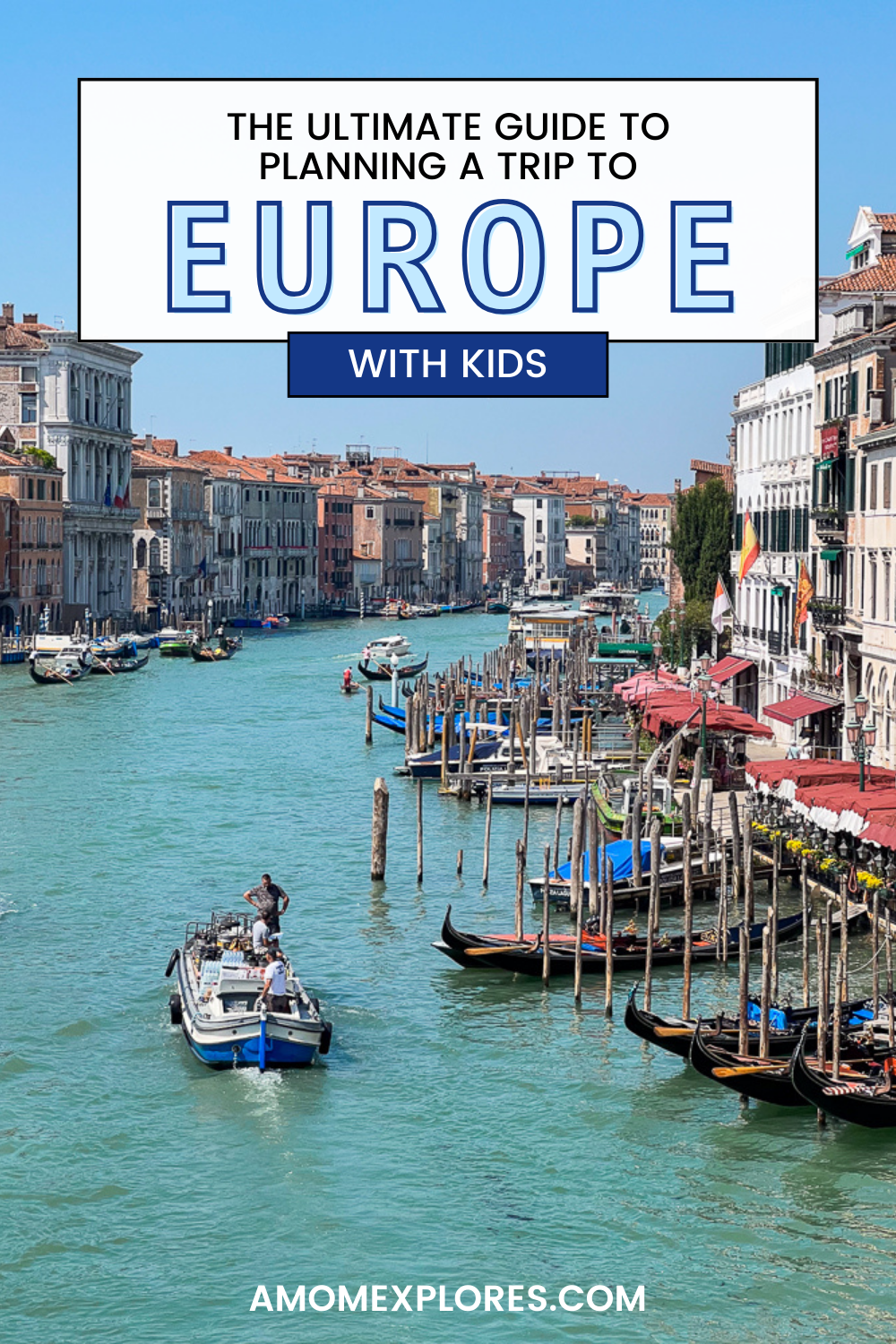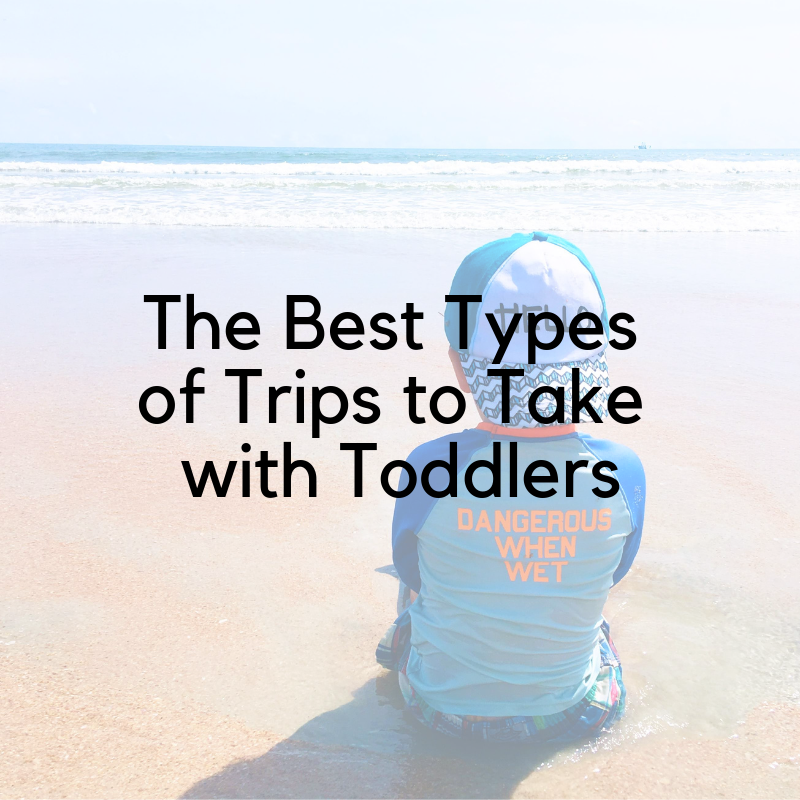The Ultimate Guide to Planning A Trip to Europe with Kids
Are you planning a trip to Europe with kids?
Planning a trip to Europe is both exciting and overwhelming. Europe contains a multitude of diverse countries and landscapes. There is an abundance of history, quaint villages, bustling cities, and breathtaking natural settings.
At the same time, overwhelm can set in quickly when you realize the logistics of visiting multiple cities or countries in one trip aren't always straightforward. While public transportation is excellent in most European cities, there's also the matter of getting to your hotel or Airbnb from the train station with all of your luggage. You may be taking a ferry to a Greek Island, renting a car to get outside the major cities, or using taxis or private transfers to get around.
When you add kids to the mix, things get even more complicated.
Many hotels in Europe have a maximum capacity of 2 or 3, leaving families with multiple children with the choice of getting 2 hotel rooms or booking a vacation rental home or apartment.
Regardless of the details, logistics, and complications, Europe is one of the best places to take your family. With so many different countries in close proximity, you can easily plan to see a few bucket list destinations in one trip. Or you can enjoy a single country and take the train to multiple cities.
It all depends on your personal travel style, and we'll cover all of the options and the pros and cons of each in this blog post.
So grab a cup of coffee and get ready to take notes. This is your ultimate guide to planning a trip to Europe with kids.
Disclosure: This post contains affiliate links. That means if you click on a link and make a purchase I may receive a small commission at no extra cost to you.
Best Time to Visit Europe
In my opinion, the best time to visit Europe is whenever your family can make it work! There are definitely pros and cons to each season, though.
Summer
Summer is my favorite time to visit Europe because the weather is nice and it's easy to pack sundresses and sandals. All of the tourist sites are open, and there's just something romantic about a European summer day, wandering through the old town or city center of some enchanting city.
The downside of visiting in summer is that everyone else is visiting, too! It's crowded, and prices are inflated. If you're someone who doesn't handle heat well, many of the popular countries to visit are quite hot, especially in Southern Europe.
Fall
The crowds are thinning, there's a chill in the air, and there's something idyllic about a fall day in Europe. I've never been to Europe in the fall, but I've heard it's the perfect time to visit with lower prices and fewer crowds.
Winter
We visited Belgium, the Netherlands, and Luxembourg (Benelux) in early February, and I expected the weather to be absolutely frigid. It was, in fact, very mild compared to our Wisconsin winters, and I enjoyed wandering around without the crowds.
The flights and hotels were fairly affordable, too!
I will say that even in February, Amsterdam was pretty crowded, but it seemed like most of the tourists were from other European countries.
The downside is that packing light is a little more difficult when you have to pack sweaters, jeans, and jackets.
Spring
Most of Europe can still be pretty chilly in the spring, but the flowers are in bloom and the summer crowds haven't descended upon the continent yet.
Determining the Length of Your Trip
Before you start looking for flights, hotels, or tours, you need to decide how long you plan to visit.
It can be expensive to fly a family across the ocean, so many of us begin with overly ambitious itineraries. We want to make the most of our time across the pond.
I can relate to that! I want to see it all, and you never know when or if you'll be able to return.
However, it's important to remember that each city or country you add to the itinerary means you'll be spending a lot of time physically traveling around the continent, packing up suitcases, walking to and from train stations, and settling into a new place.
Kids make moving around even more difficult. If you have babies and toddlers you'll be working with extra gear like baby carriers and strollers. And younger kids won't really be able to help carry the bags. They'll be tired and hungry, jet-lagged, and bored.
So how much time do you need in Europe?
Talk to the deciding members of your family and determine what everyone's non-negotiables are for the trip, then figure out what a realistic amount of time to visit all of those spots would be.
I think 2 weeks is a perfect amount of time to visit Europe with young children.
1 week can feel too short but might work if you're only planning to visit one major city.
3 weeks can feel too long, and you don't want to end your trip with crabby family members.
Finding Flights
Once you've determined how long you want to be in Europe, it's time to book flights.
In recent years, flights to Europe have been much more expensive, especially during the summer months. However, I have a few tricks up my sleeve for finding more affordable flights to Europe.
After all, we are a family of 6, so getting from the United States to Europe in summer can really add up.
The number one key to saving money on flights to Europe is flexibility. You need to be flexible with your dates, or flexible about your destination.
If you know your dates are fixed, you can search your home airport, but don't forget to check nearby departure airports, too! It might be worth it to drive a few extra hours to save a few hundred dollars per person on a flight.
You can also be flexible with your destination airport.
One big mistake I see many people make is that if they want to start their trip in Rome, they only search for flights from their home airport into Rome for fixed dates. But flexibility is the key to finding cheap flights
So my favorite way to find cheap flights into Europe is to find the cheapest flight option to ANYWHERE in Europe, then figure out transportation to my desired destination. It's much cheaper to fly or take the train around Europe, so it's easy to get from Point A to Point B.
In addition, if you can be flexible about your flight schedule, you'll end up paying less, though it will likely be an inconvenient schedule with long layovers. Direct flights are usually more expensive, but if an efficient flight experience is worth the extra money to you, go for it! I think it makes a lot of sense for families with young children to book direct flights and avoid layovers.
Google Flights
The best way to find cheap flights is by searching on Google Flights. I always begin my search here.
Google Flights has several features that make searching for cheap flights much easier.
An easy way to compare flight prices is to log into Google Flights and click the "Explore" tab at the top. Enter your home airport, then leave the "Where To?" section blank. Then you have the option to enter specific dates, or to leave it more vague, like "2 weeks in June." Then click "Done."
Flight prices will start to populate. The map is interactive, so you can zoom out, and scroll over to Europe on the map, then zoom back in to see what flight prices are like into different European countries.
If one city is significantly cheaper than the others, go ahead and look that flight up on the airline's website. You can't book flights on Google Flights.
An alternative way to search if your dates are flexible is to type in your home airport and your destination of choice (for example, Rome), then click on the Departure date box. A calendar will drop down with flight prices. Look for the green flight prices, as those are the cheapest options out there!
Going
Another one of my secret weapons for finding cheap flights is having a subscription to Going, formerly known as Scott's Cheap Flights.
Going is a service that sends cheap flight deals to your inbox. There are several subscription levels to choose from. The free option (Limited), includes only economy deals within the continental United States. Premium (what I recommend for most families that love to travel) includes economy class deals to domestic and international destinations, and includes mistake fares, and points and miles deals. Finally, the Elite membership offers everything included with Premium but adds deals for Premium Economy, Business Class, and First Class.
Going often sends deals to Europe under $500, especially during winter and shoulder season. I haven't seen as many great deals during the summer months, but they occasionally happen. Keep your eyes peeled for great deals landing in your inbox! I've found the best deals when I let the deal choose the destination.
Book on Points and Miles
Recently, I've become more interested in using points and miles to book travel. As a family of 6 that travels multiple times each year, using credit card reward points and airline miles has been a great way to save some money on our travels.
The most efficient way to earn a lot of points at one time is to sign up for a new credit card. Many credit cards have a signup bonus that awards you a large sum of points (anywhere from 60,000 to 150,000) if you meet the minimum spend in a designated period.
For example, a card might specify that to earn the signup bonus of 60,000 points you spend $4000 in the first 3 months of owning that card. The countdown starts as soon as you are approved for that card.
When I'm working on the minimum spend for a new card, I put all of our groceries, gas, and incidental spending on the card. I also try to time big purchases or payments with a new card to help me meet the minimum spend faster.
I've found as a family of 6, it is pretty easy to spend $3,000 or $4,000 in 3 months just by putting our everyday purchases on the card. I'm never spending more than we have in our bank account, or making extravagant purchases I wouldn't otherwise make.
If you struggle with self-control and paying off credit cards, this might not be the right move for you. Always be a responsible credit card user or the benefits of points and miles will be negated by the credit card debt you're carrying.
A Personal Note: The reason I don't always think this is the most realistic strategy for families is that you have to earn A LOT of points to fly your entire family to and from Europe. A VERY low price for roundtrip flights would be around 40,000 points per person, which means even for a family of 4 you would need 160,000 points. In addition, it's not always easy to find available award flights for your whole party.
What card should you sign up for to earn points for flights to Europe? I would suggest choosing a card with flexible points rather than a specific airline's card. I prefer the Chase Sapphire Preferred, but other great flexible points cards include the Capitol One Venture.
These cards come with an annual fee, but they also come with perks you can use for travel, like a credit for TSA Precheck or a $50 hotel credit. Be sure to check the fine print whenever you sign up for a card, and take advantage of all the perks to make the most of the annual fee!
Once you have earned the points, you can transfer them to the bank's partner airlines.
I just booked flights to Europe on points for the first time this year by transferring my Chase Ultimate Reward Points to Virgin Atlantic while they were offering a transfer bonus of 25%. That means I got an additional 25% points when I transferred from Chase to Virgin Atlantic. I was able to book flights on points for my daughter's birthday trip to Scotland. That way, all we had to pay for were taxes and fees.
I have an episode on my podcast all about booking flights for families on points and miles with a points and miles expert! Listen to the episode here, and you can find all of her resources for learning more in the show notes.
Make an Outline of Your Itinerary
Once you have your flights booked, the next step is to outline your itinerary.
There are a lot of logistics to figure out, from train schedules to finding accommodations that fit your whole family, so this should be more of a first draft.
In my opinion, this is the most enjoyable part of the process. Your task is to watch TikTok and YouTube videos, search destination ideas on Pinterest, and scour blog posts and guidebooks for the countries, cities, landmarks, tours, and experiences that stand out to you.
If your kids are old enough to help, you can also get their opinion on what to include in your Europe itinerary. By doing research and giving their input, they will start to take ownership of the trip. When they feel like they have some control, they seem to enjoy the trip much more than if you're dragging them to museums and churches they know nothing about.
As a family, decide on the best things to do in the countries you'll be visiting, but be realistic about how much you can fit into your trip. Don't forget that adding more cities to your itinerary means more travel time on trains, planes, and ferries. Even though everything is a lot closer together than in the United States, it still takes up a large part of your day to pack, make your way to the train station, port, or airport, travel, and find somewhere to store your bags until your hotel room or vacation rental is ready.
Especially if it's your first trip to Europe, those small details like storing bags and knowing how you'll get to the train station can come back to haunt you when you are dragging suitcases over cobblestones at 7 a.m. to make your train.
We moved at a pretty quick pace on our trip to Italy and Greece in 2023. We visited 5 cities in 2 weeks, and it felt like a lot of moving around. It was worth it for all we got to see, but it was still exhausting to be moving around that much with 4 young kids. I would say you need to spend at least 2 nights in a city when traveling with kids to make it worth it.
How to Outline Your Itinerary
My process is to create a table in Google Docs with 2 columns. The first column has the dates of our trip, and the second column has a brief description of where we'll be and what we'll be doing.
As you get further into the planning process of booking hotels and tours, you will make one table for each day of the trip. Having the bird's eye view outline of your itinerary helps you know the details at a glance.
Here’s an example of the overview of our most recent trip to Belgium. As I plan more of the trip, I had individual tables for each day of our trip.
Finding Family-Friendly Accommodations
Now that you know which cities you'll want to visit, it's time to find your hotels or vacation rentals.
This can be one of the most challenging parts of booking a trip to Europe for families with more than one or two children because hotel in most of Europe have very strict occupancy rules. Many hotel rooms are only for 2 or 3 people. If you're lucky you might find a quad room.
Here in the United States it's common to find family suites, or to squeeze a 5th person into a standard hotel room.
You won't be able to do that in most hotels in Europe, as they need to check all of your passports when you check into the hotel. If you put that you only have 3 people, then try to sneak an extra kid into the room, you may end up having to pay for a second room when you arrive, which would not be cheap.
So the options for big families are to:
book 2 (or 3)) hotel rooms. Often the hotel cannot guarantee that they are connecting.
Search for "family rooms" in your initial search for hotel rooms
Search for "apart-hotels" - apartment style hotel that may have more space
Search for "kinder hotels" - family-friendly hotels that are more like all-inclusive resorts. These would not be for basing yourself in a big city.
Search on Booking.com for more options. Enter the number of guests and the children's ages, and you can filter the results by hotels, apartments, breakfast included, airport transfer, or whatever other factors you feel are important for your family.
Use Airbnb, VRBO, or KidCoe to book a vacation rental
Keep in mind that while hotels and rentals outside of city center may offer more space and lower prices, you'll have to deal with a commute in and out of the city each day, which can add up very quickly.
We much prefer staying as close to the city center as possible when visiting a larger city in Europe so we are within walking distance of the main attractions.
The earlier you can book accommodations the better. You will have more options available and prices might even go up as your date gets closer.
Booking Transportation
Booking trains, planes, airport transfers, and ferries is probably the least enjoyable part of planning your trip to Europe, but it must be done. Thankfully, public transport is excellent in many European cities.
Train Travel
Train travel is very common and efficient in most parts of Europe, so we will often choose train travel to get from one city to another, or for a day trip to a nearby town.
If you are booking a train between two European countries, check Eurail. They offer individual fares or the Eurail Pass for those who want to visit multiple cities or countries. There are different Eurail passes. The Global Pass allows you to visit over 30,000 destinations in 33 countries around Europe. There are Flexi Passes that allow you to choose anywhere from 4 to 15 days within a month that you'll use the pass, or Continuous Passes that allow you to use the pass daily for anywhere from 15 days to 3 months.
They also have Country Passes which allow you to buy passes for a single country.
Each country also has a national train line, and you can book train tickets directly on their website or app.
Renting a Car
Many people suggest renting a car in Europe to get off the beaten path and outside the big cities.
We have not opted to rent a car in Europe yet since train travel has been easy and efficient, and all of the places we've visited so far have been able to be reached by train.
As a family of 6, we know we would have to rent an SUV or minivan to fit our entire family, and navigating the narrow streets of the Old Country in a larger vehicle might be difficult.
Still, it's something I would love to do someday, as it offers you more freedom and flexibility for exploring lesser-known parts of Europe.
Flying
Sometimes booking a flight around Europe is necessary if you're trying to get from one end of the continent to another quickly. Or, for example, if you want to visit Greece, which is harder to reach by train.
Flights within Europe are usually much cheaper than flights within the United States, and you can usually get from one city to another for less than 100 euros. We flew both Aegean Airlines and Ryan Air between Italy and Greece, and the budget airlines were not nearly as bad as I thought they were going to be! We had plenty of legroom, and as long as you make sure to pay for your luggage up front when you're booking the tickets, you won't have to deal with any surprising fees.
Ferries
If you're visiting an island in Europe, you will likely have to take a ferry (unless you can find an affordable flight to the island of your choice).
We booked our ferries from Athens to the Greek Islands on FerryHopper and had a great experience. but you can also check the ferry operator's website to book tickets.
Take a Guided Tour
Guided tours are not usually my style of travel, since I like to operate on my own schedule. However, there are some circumstances where a guided tour might help you see European destinations you might otherwise miss.
For example, on our week long trip to Belgium and Amsterdam, we booked a day trip through GetYourGuide to visit Dinant, Belgium, and Luxembourg City in one day. It was a 3-hour bus ride, and once you arrived in the cities on the itinerary you had a set amount of time to wander on your own before meeting the bus.
It was a great way to see more without having to make all of the travel plans. Plus we had the added benefit of a tour guide to give us some background information and history.
The tour we chose stored my stroller underneath the bus in between destinations, and we even saw other families with babies on the tour, too!
Finalizing Your Itinerary
Now that the logistics of accommodations and transportation are figured out, you can start booking the tours, classes, and tickets for museums you want to visit on your trip.
It is so important to book tickets ahead of time, especially if you are visiting Europe during the high season. Most attractions require timed entry tickets that you purchase in advance on the website. If you don't plan ahead, you could be waiting in line for hours in the hot sun, or miss your chance at seeing a site you really wanted to see.
I don't usually like to have my trips planned down to the minute and prefer some flexibility in my itinerary, but I realized quickly with our trip to Italy and Greece that we needed to be organized if we wanted to see the popular destinations like the Vatican, the Colosseum, the David Statue at the Accademia, and the Acropolis.
Booking Tours, Classes, and Museum Visits
You can book tickets for most museums right on the website. If you want a special guided tour, you can also usually find those on Viator and GetYourGuide.
I would recommend picking a few spots on your Europe trip that are really important to you and booking a guided tour. We chose the Vatican, since the museum is so vast, and the Colosseum in Rome. Our guide for the Colosseum and Roman Forum was incredible. He had a great sense of humor, kept our attention with interesting stories, and involved the kids to make sure they were learning and having fun, too! I don't think visiting the Colosseum would have made as much of an impression on my kids as it did if we hadn't taken a guided tour.
Private tours are often very expensive but come with a personalized experience and sometimes a private driver. Small group tours are great, and usually much more affordable for the average family.
One tip for taking a guided tour with kids: bring your kids' headphones on the tour. The tour usually provides cheap earbuds so you can hear the tour guide as they are walking. These earbuds always ended up being too big for the kids' ears, so they would take them out and miss most of the tour.
Finally, if you have time, it's fun to book a class to learn a local skill. This could be a cooking class in Florence, a baking class in Paris, or a mask-making class in Venice.
It's also fun to see if there are walking tours, canal tours, river cruises, or bike tours offered in the city you're visiting to see the city from a different perspective.
Packing for Europe with Kids
My best tip for packing for a trip to Europe with kids is to pack as lightly as possible.
We knew we would be changing cities often, which meant carrying our luggage to and from train stations, ferries, and airports. Our kids are still young, which means we would end up carrying most of the luggage.
For that reason, we decided to bring just one backpack each, plus one small carry-on suitcase for overflow. We also had a stroller for our toddler.
Packing light ended up being a good idea for several reasons. My husband and I could each carry one backpack on our back, and one on our front. We could put one backpack under the stroller, and one on top of the suitcase. This way our hands were free to help the kids on busy streets, and the kids weren't complaining when they had to walk a mile to the train station.
In addition, we only had a few outfits to choose from which helped eliminate decision fatigue. Any parent who has traveled with kids knows that by the end of the day, you're exhausted from deciding what to eat and where, how much to try to fit into the day, and keeping your wits about you in an unfamiliar place. Not having too many outfits to choose from made life much simpler.
We did count on having washing machines in a few of our vacation rental apartments, and when we didn't I would simply do some sink laundry and hang the clothes to dry.
You can read about everything I packed for our 14 day Europe trip in this blog post: Packing for A Family Trip to Europe with One Backpack Each
Planning for Meals
One of the things I worried about most before the trip was where we would eat as a family of 6. We are not foodies by any means, and we have a few picky eaters in our family. In addition, I was worried that our family would be too big to fit inside the tiny restaurants, or that waitstaff would be annoyed by our kids.
I truly had nothing to worry about. Everywhere was so accommodating to our family, and servers went out of their way to make our kids feel welcome.
Breakfast
Breakfast is usually either the free continental breakfast at our hotel, or if we're staying in a vacation rental we will pick up coffee and pastries at a bakery!
Lunch
I try to make lunch our biggest meal of the day. I know how long dinner can take in many parts of Europe, and that many European countries eat dinner much later than we are used to. For that reason, we typically go out for lunch. As a bonus, it usually ends up being cheaper than dinner!
Dinner
For dinner, we will either pick up something to go and eat back at our apartment, like a pizza, or cook dinner in our apartment with food from a local market or grocery store. I always like to go out for ice cream or gelato sometime in the late afternoon to hold us over until dinner!
By this time of day we're exhausted from exploring, and by eating in our hotel room both the kids and adults can relax and decompress from the day.
How Much Does It Cost to Visit Europe with Kids?
The answer to this question will, of course, depend upon how many people are in your family, what time of year you visit, how long you stay, how often you're moving around to a new city, and what your travel style is.
I calculated how much money we spent on our 2-week trip to Italy and Greece with 4 kids including flights, food, accommodations, activities, and transportation around Europe. It was the perfect trip for our family, and this guide will be a great starting point for you to figure out how much you might spend on your own trip.
The flight cost was, of course, our biggest expense. You can read how much it costs for a family trip to Europe here.
Tips for Visiting Europe with Kids
Jet Lag
If you're flying to Europe from the United States or Canada, you will likely have to battle jet lag.
To combat the effects of jet lag, we make sure to get outside and explore on our first day. We try not to take a nap and go to bed at our normal time. We also use kids' melatonin (which we discussed ahead of time with our pediatrician) as needed. Always talk to your pediatrician before using sleep aids with your kids!
Sunlight, hydration, and getting on the local schedule as soon as possible are key to making sure jet lag doesn't ruin your trip!
Keep a Journal
Writing about the sights, sounds, and events of the day is a great way for kids to decompress and process everything they did and saw.
Plus it will make for a great souvenir when they get back! It will be so fun to look back and remember all of the amazing things they got to do.
I created a travel journal for kids that you can use for up to 3 trips!
Schedule some Down Time
Let's face it. Not every kid will be thrilled about visiting museums, churches, and famous landmarks. Even if they enjoy it, they still need some time to unwind and just be kids. Build in time to relax at your hotel or Airbnb, or just go to parks and playgrounds where they can run around.
We no longer have kids who take afternoon naps, but we still tried to go back to the Airbnb for a couple of hours in the afternoon before heading back out for the evening just to give everyone a mental break.
Our Favorite Travel Stroller
We love our Zoe Tour stroller for travel! It worked great on the cobblestone streets and sidewalks of Venice, Florence, Rome, Paros, Athens, Bruges, Ghent, Brussels, Amsterdam, and Luxembourg. This stroller has seen it all!
We love that it is lightweight, folds up and sets up easily with one hand, and is small enough to fit in the overhead bin of many airlines.
Use my link to get $15 off your first purchase!
Pack Familiar Snacks
As amazing as the food is in many European countries, there's nothing like the taste of home. You might be traveling for a few weeks at a time, and it's nice for kids to have a stash or their favorite snack as a comfort food.
Try European Fanta
This is kind of a niche tip, but my 6-year-old definitely struggled with all of the walking and museums. He was too old for the stroller, but a bit too young to appreciate what he was seeing.
He ended up LOVING the Fanta (orange soda) in Europe, and we discovered it tasted more like sparkling lemonade than soda.
Listen. I'm not above bribes, so the Fanta fascination came in handy.
Where to Go in Europe with Kids
Here are a few destinations I've enjoyed visiting with young children. Most of our trips to Europe have been in Western Europe and Central Europe, so unfortunately I don't have many recommendations for Eastern Europe.
Hopefully, these suggestions will give you an idea of what to add to your European tour!
London
London is so easy to navigate with kids and the public transportation like the tube and the double-decker buses are excellent! Because they speak English, it's a great "starter" city to visit if you're new to international travel with kids. See the Tower Bridge, visit the British Museum, get a panoramic view of the city on the London Eye, and wander Notting Hill. Get some itinerary ideas here: Planning a London Vacation the Whole Family Will Love
Paris
If you're already in London, why not take the high speed train to the City of Lights? Have a picnic under the Eiffel Tower, see the Mona Lisa at the Louvre, eat crepes along the Seine, take a river cruise, and climb the Arc de Triomphe. There are endless things to do with kids in Paris.
Venice - Florence - Rome
Last year we spent a week in Italy with our 4 kids exploring some of the most historic cities: Venice, Florence, and Rome. We spent 2 nights in each city, which was quite a whirlwind! The kids loved the pasta, gelato, pizza, incredible sites, and kid-friendly tours. 1 week was NOT enough time to truly enjoy Italy, but we worked with the time we had.
We didn't make it to Cinque Terre, the Amalfi Coast, or Lake Como, so we're hoping to return to Italy for a longer stretch of time to explore some more! Read our perfect 2-week Italy and Greece Itinerary here!
Amsterdam
I loved visiting Amsterdam on a quick weekend trip with my 3-year-old, and the small taste of this beautiful European city made me want to return for more! If you like Stroopwafel, fries, history, and charming canals, this city is for you! It was very kid-friendly, and I had no problem getting around with a stroller. I even took my 3-year-old to the Anne Frank House, and while the subject matter went over her head, I thought they did a good job of making the information accessible to kids without shying away from the horrors that occurred.
Read what to do in Amsterdam with Kids.
Belgium
Belgium is a great place to visit with kids and is often overlooked in favor of bigger countries like France, Germany, and Italy. Because of its location in the center of Europe you'll have easy access to other countries and cities like Paris and Amsterdam if you want to add those on to your visit. I loved visiting the fairy tale town of Bruges with my 3-year-old, and Ghent, Brussels, and Dinant were fun to visit, too! Here's my Belgium itinerary.
Greek Island of Paros
I'm sure there are a lot of incredible Greek Islands to visit with kids, and if we had had some extra time in Greece we would have done some island hopping. However, we only had a few nights, so we chose the Greek Island of Paros, and it was paradise on Earth. We found some family-friendly beaches, idyllic towns to wander through, and a good place to stay on the island that fit our family of 6 and had a pool. Read all about visiting Paros with kids here!
More Europe Travel Tips for Families:
Tips for Traveling with a Toddler
DON’T FORGET IT! PIN IT!
Emily Krause is a Wisconsin-based travel content creator who writes about exploring the world with kids.
On A Mom Explores you’ll find the best family travel destinations, Disney World tips, and how to make travel with babies and toddlers a little easier.
Emily believes that exploring starts in our own backyards, and adventure can happen anywhere with the right mindset.





























